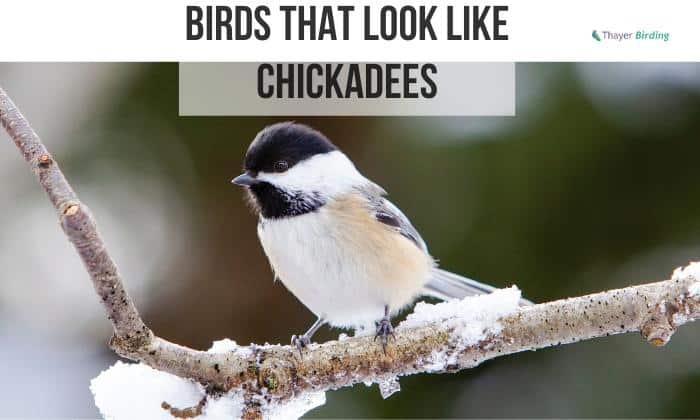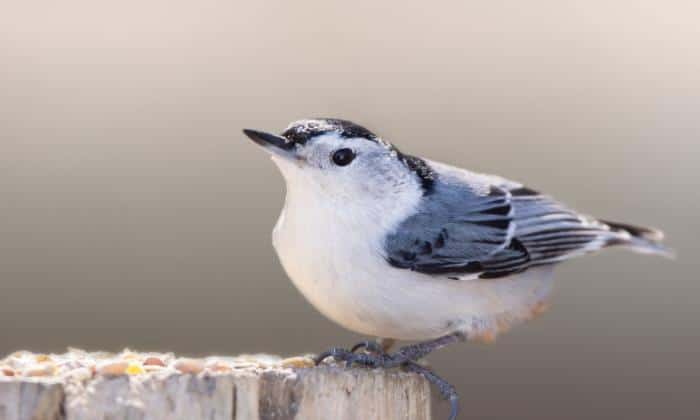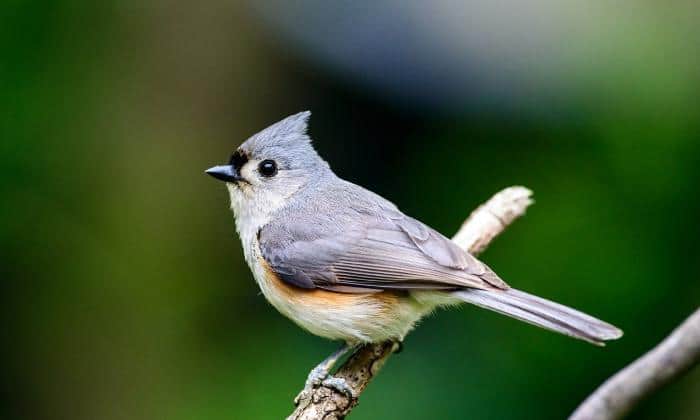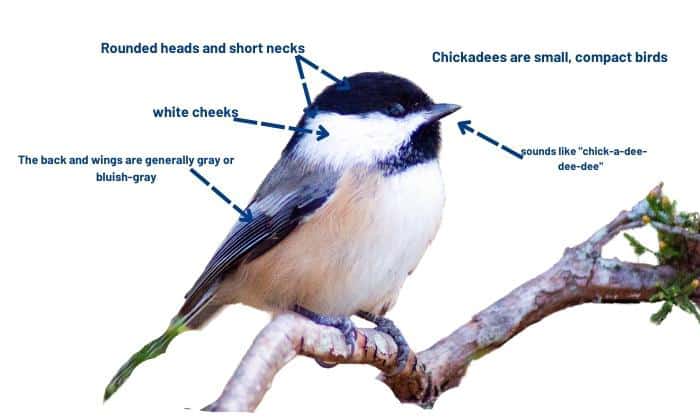Chickadees are a group of small passerine birds found in North America. The most popular species is the black-capped chickadee, the state bird of Maine and Massachusetts.
Chickadees have a distinctive appearance, but this bird also shares some features with other songbirds, that’s why it is important to know how to tell them apart.
Below is a list of birds that look like chickadees and how to identify them. Read on to know more.
Table of Contents
Characteristics of Chickadees
Chickadees are small passerine birds known for their charming demeanor and distinctive vocalizations. These delightful avian creatures, often found in North America, exhibit various traits that make them fascinating.
There are various types of chickadees, yet these small-sized birds (12-15 centimeters) typically have distinctive caps and bibs that are usually darker than the rest of their body. The feathers on the lower parts are white and brown on the sides.
Another notable characteristic of chickadees is their unique vocalizations. Their famous “chick-a-dee-dee-dee” call is not only distinctive but also serves as a means of communication, conveying different messages to their fellow flock members.
There are birds similar to chickadees in size and coloring, and can be easily mistakenly identified as one. They will be discussed in the succeeding section, and the subtle differences between species will be highlighted to help you properly identify these birds when you come across them.
Birds That Look Like Chickadees
1. White-breasted nuthatch (Sitta carolinensis)
- Length- 13-5 centimeters (5-6.1 inches)
- Weight- 18-30 grams (0.63-1.06 oz)
- Wingspan- 20-27 centimeters (7-10 inches)
This small passerine bird of the Sittidae has light blue or gray feathers on the upper body and whitish on the lower parts.
The male’s head is topped with a black crown, while females usually have a grayish coloration. This bird with a long beak, also has a reddish or chestnut-colored patch on the abdomen.
The white-breasted nuthatch is a bird that lives in deciduous forests and open woodlands such as parks, gardens, and suburban areas. These birds usually build their nests in the natural cavities of trees and even use nests abandoned by woodpeckers.
Nuthatches like to eat insects but are considered omnivores since they also consume various nuts and seeds. They are notably similar to woodpeckers in terms of feeding because they forage on tree trunks and branches.
To differentiate from the chickadee species, the white-breasted nuthatch’s black cap does not cover the eyes like a mask but is only found on its crown. They also don’t have black bibs on the chest.
2. Black-tailed Gnatcatcher (Polioptila melanura)
- Length- 11.43 to 12.27 centimeters (5 to 5 inches)
- Weight- 5.1 to 6 grams
- Wingspan- 14-15 centimeters
This black-and-white bird is small but has a distinctive long black tail with a mix of white feathers on the outer part. It sports a black cap like the chickadee that extends around the eyes like a mask. The upper body is blue-gray, and the lower parts are white.
The black-tailed gnatcatcher is a non-migratory bird found in the southwestern parts of the United States and Mexico. It is a small bird that inhabits arid habitats such as deserts, usually living in salt bushes, mesquite, and cacti.
Their diet is composed predominantly of insects such as caterpillars, beetles, ants, and spiders. Seeds and fruits are also consumed as supplements to their intake.
How to tell the difference between a black-tailed Gnatcatcher and a chickadee?
Both have black caps, but the black-tailed Gnatcatcher does not possess a black bib and has whitish flanks, while the chickadee has brownish feathers.
3. Tufted Titmouse (Baeolophus bicolor)
- Length: 14-16 centimeters (5.5-6.3 inches)
- Weight: 17-26 grams
- Wingspan: 20-26 centimeters (7.9-10.2 inches)
The chickadee and the tufted titmouse belong to the same family (Paridae). The tufted titmouse shares similar physical characteristics with the chickadee but is bigger in size. This small, stocky bird is gray on the upper parts and white below with peach to rust-colored flanks.
It has a gray crest on top of its head, which is absent in chickadee species such as the black-capped chickadee. They have a black mark on the forehead just above the beak.
The tufted titmouse is native to North America. It is a common resident of deciduous woodlands as well as shrubby areas as well as parks, and orchards.
They are considered foliage gleaners as they fly from one branch to another to gather food, such as insects, seeds, fruits, and berries. In the summer, their diet is composed mostly of insects, including caterpillars, ants, stink bugs, and spiders.
4. Blackpoll Warbler (Setophaga striata)
- Length: 12.5 to 15 centimeters (4.9 to 5.9 inches)
- Weight: 9.7 t 21 grams (0.34 to 0.74 oz)
- Wingspan: 20 to 25 centimeters (7.9 to 9.8 inches)
This bird belongs to a group of New World warblers living across North America and Canada. They are small migratory birds, very lightweight but are capable of flying non-stop, long-distance during winter.
The male blackpoll warbler has a distinctive black cap during the breeding season. They have white cheeks and white wing bars. The black head of this warbler is similar to the chickadee but smaller and less rounded in shape.
During the fall, this black-and-white bird loses its remarkable coloration when it molts, and the feathers turn into a yellow-green hue. During the summer, it turns into a brown bird with a white face and black crown.
Their diet consists mainly of insects, with spiders being on top of their meal choice. Aside from that, they also eat ants, beetles, caterpillars, and flies. During winter, they eat fruits and berries.
5. Black-throated Sparrow (Amphispiza bilineata)
- Length: 12-14 centimeters (4.7-5.5 inches)
- Weight: 11-14 grams (04.-05 oz)
- Wingspan: approximately 20 centimeters (7.7 inches)
Considered a New World sparrow, this bird is the sole representative of the genus Amphispiza. This species is found mainly in the southern parts of the United States and parts of Mexico.
This passerine bird is medium-sized and gets its name from the dark patch on its throat. The upper body of the black-throated sparrow is gray, and the underparts are white all over.
It is one of the passerine birds that look. However, it can be distinguished from a black-capped chickadee by the pattern on its head: two white stripes are found above and below the eyes. Chickadees also have a black cap on the head, while this new world sparrow does not have one.
The black-throated sparrow is omnivorous, feeding on both insects and seeds. It is a ground forager, commonly found looking for food under shrubs and cacti in semi-open areas such as desert scrub habitats and canyons.
6. Great tit (Parus Major)
- Length: 5-14 centimeters (4.9-5.5 inches)
- Weight: 12 to 22 grams
- Wingspan: 24 centimeters
The great tit is a common species of bird that is found mainly in Europe, the Middle East, and Central Asia. It belongs to the Paridae family, which includes species of chickadees, tits, and titmice. Thus, it is no wonder that the great tit does look like a chickadee with a yellow breast.
The great tit has a striking appearance with a black head, neck, and contrasting white cheeks. They share these head markings with the black-capped chickadee. Still, the yellow breast and underparts set them apart from their North American counterparts, which have stark white plumage on the lower parts of their body.
This bird is mainly an insectivore but it also consumes other types of foodstuff during winter such as bats, berries, fruits, and seeds. The female great tit builds its nest mostly in cavities such as holes in trees.
7. Bushtit (Psaltriparus minimus)
- Length: 11 centimeters (4.3 inches)
- Weight: 5 to 6 grams (0.18-0.21 oz)
- Wingspan: 2 centimeters (6 inches)
The bushtit is a social songbird, one of the smallest passerine birds inhabiting North America’s shrubs and woodlands. This brown bird has a stocky build, a big head, a lengthy tail, and a short beak.
The male bushtit has a black mask over the eyes that resembles the chickadee’s. The overall color of this bird is grayish brown in contrast to the chickadee’s white lower plumage and brown flanks.
The American bushtit is found all year round in the western parts of the United States, elevated parts of Mexico, and Canada. This species is also found in Guatemala.
It is a vigorous forager of small insects and spiders. They rarely eat plants but are known to consume seeds such as olive and willow seeds.
Tips for Identifying Chickadees and Similar Birds
1. Size and Shape
Chickadees are small, compact birds with rounded heads and short necks. Pay attention to their overall build and the chickadee’s size compared to other birds in the area. Chickadees are usually smaller than sparrows but larger than finches. They have plump bodies and relatively short tails.
2. Coloration
Chickadees have distinctive plumage patterns and facial markings. Look for a black cap and bib on the head, with white cheeks extending to the neck.
The back and wings are generally gray or bluish-gray, and the underparts are light gray or white. Color is a salient feature to distinguish birds that look like black-capped chickadees and the real ones.
3. Vocalizations
Chickadees are known for their unique and complex vocalizations. Listen for their typical “chick-a-dee-dee-dee” call, which is often used for communication within their flock. They may also produce various whistles, trills, and warbles. Familiarize yourself with their calls by listening to recordings or using birding apps.
Conclusion
Birds that look like chickadees can present an exciting challenge for birdwatchers and nature enthusiasts. While the black-capped chickadee itself is a distinctive and easily recognizable bird, other species share similar traits, making identification a fascinating endeavor.
By patiently studying their characteristics, behaviors, and habitats, bird enthusiasts can unravel the mysteries of these avian doppelgangers and enjoy the diverse wonders of the natural world.
If you enjoyed reading this article, please share it to your fellow bird lovers. Happy birdwatching!

George and I became friends after a birdwatching trip with our new group. And we have been enjoying every adventure together. When he told me the idea of establishing a site that shares our experiences and fun, I immediately agreed. After trials and errors, here we have Thayerbirding.























